Menu



If you’ve gone your whole life thinking edible mushrooms were a palatable yet relatively insignificant vegetable you could find in the produce aisle, we have a pleasant surprise for you: mushrooms hold the potential to break down and absorb some of the most toxic human-created waste through mycoremediation!
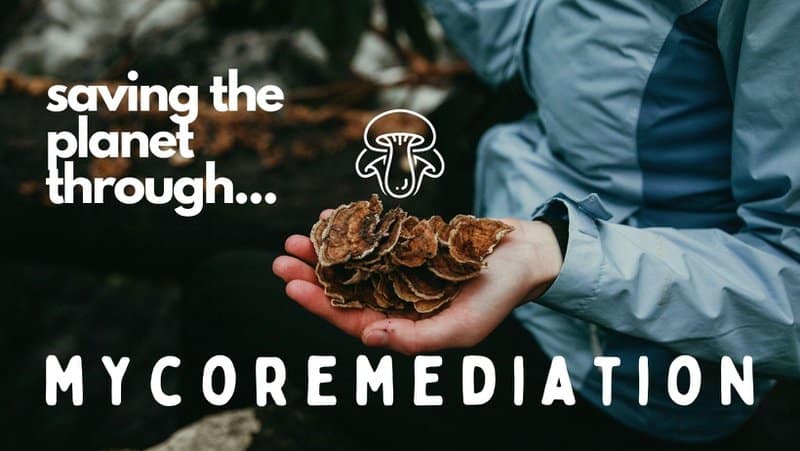
The highly absorbent nature of fungi and their mycelial “root systems” support ecosystems by ingesting nutrients from the plant matter they decompose and re-dispersing them to other plants and trees. Fungi’s natural function as super-powered decomposers and nutrient dispersers has served as the backbone of almost all ecosystems.
If this sounds radical, consider their origins. For instance, fungi began existing on land hundreds of millions of years prior to plants. One of the enzymes fungi produce, oxalic acid, is postulated to be the catalyst for the degradation of minerals and rock that became the calcium-rich soil that plants grow in [23]. Consuming hard-to-breakdown organic compounds makes fungi an ideal agent to turn to for solutions to the problem of human waste and environmental pollution.
Fungi were around long before us (by about a billion years) and have adapted to every kind of environment imaginable. For example, many fungi developed the ability to live without sunlight (something plants are not able to do as of yet). This was an adaptive response that occurred 65 million years ago after an enormous asteroid hit the Earth and the resulting dust cloud and obscured sunlight [23]. As we will explore, fungi’s highly adaptable natures also make them ideal agents for environmental healing.
These unique beings may hold the key to reversing the tremendous havoc humans have been wreaking on our planet. By using their natural powers of absorption, decomposition, and adaptation, other mushroom species can help us make amends to this beautiful planet through mycoremediation.
Mycoremediation is “the use of fungi and mushrooms (the fruiting body of fungi) for the removal of waste from the environment [1].”
“Clean technology” is a trending concept in the modern age where the awareness of climate change and environmental destruction is coming into our human consciousness. It is an effort to “maximize production while simultaneously reducing waste generation, treatment and conversion of waste into some useful form [1].”
It just so happens that the concept of waste conversion has been in the consciousness of Kingdom Fungi for a billion years—in a sense, they are the “OG” recyclers of the Earth. Mycoremediation is the very reason the forests are lush and beautiful rather than full of stacks of dead animals and bits of expired natural shrapnel.
In fact, we can use a variety of cultivated mushrooms to combat the mass human waste that is degrading the condition of our earth and atmosphere. By allowing mycoremediation to work its enzymatic magic on a variety of man-made pollutants and byproducts, we can tap into a billion-year-old solution for naturally breaking down waste into non-harmful and even USEFUL materials [2].
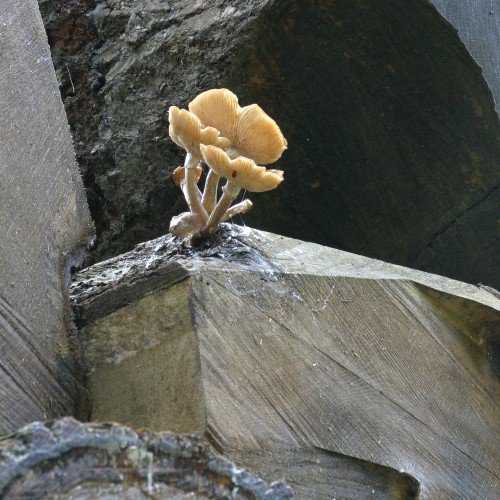
In nature, fungi and their mycelium-based networks (the “root” structure) are the reason our forests are able to constantly regenerate without interaction from humans. Have you ever noticed how abandoned buildings and old sidewalks somehow morph when left alone? Over time, you can spy life stretching through the cracks of the bricks, moss spreading itself up the sides of concrete walls. The symbiotic relationship plants have with wild mushrooms allows them to thrive and continue to regenerate even when there has been mass destruction to the natural ecosystem.
Fungi work by breaking down organic plant and wood material, though we are now finding that they have the ability to break down much, much more.
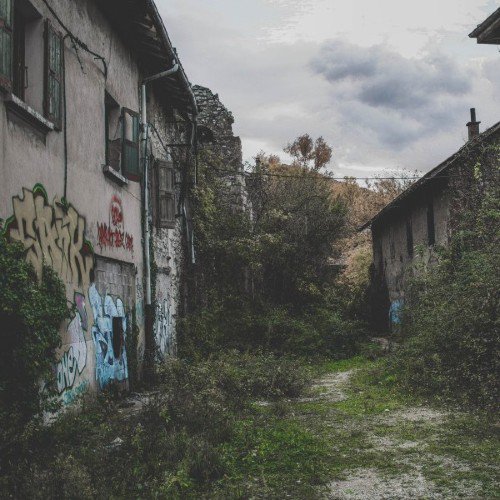
The process of natural decomposition works through enzymatic reactions. These enzymes include peroxidases, liginases, cellulases, pectinases, xylanases, and oxidases, all of which are masters at breaking things down (enzymes ending in “-ase” typically mean to “break down.” i.e. ‘lipases’ break down lipids, etc.).
Such enzymes are inherent byproducts of fungi, and they have massive implications for cleaning up the contamination we have left behind. As mycelium spreads, it secretes these enzymes, which can break down pollution. Fungi are the forest’s Day 1 recyclers, breaking down organic plant and wood material.
Fungi have been around since long before us, and they offer a natural and specially adapted form of intervention for reversing the impact of human waste. So, without further ado, here are 8 ways that mycoremediation can break down pollution and decontaminate our ecosystems.
Humans cannot exist without water. It follows, therefore, that the lack of access to clean water can keep people in poverty because it holds back development. There are currently 785 million people (1 in 10) globally who do not have access to clean water. Additionally, there are 2 billion people living without the means to adequate sanitation, much of which relies on clean and safe water access [24]. However, the clean-water issue is not limited to just third-world countries.
Urban cities where people regularly consume clean drinking water are also affected by the quality of their H2O. In fact, instances of lead or other contaminants in drinking water are not uncommon in North American tap water.

Mycoremediation exists as a subclass of bioremediation—using microorganisms to break down contaminants by using them as a food source. Mycofiltration is a type of bioremediation that can help keep water sources clean by using indigenous metallotolerant fungal isolates to degrade pollutants in the water before they are able to reach larger bodies of water.
One specific mushroom, the oyster or Pleurotus ostreatus has been shown to purify water through its ability to remove contaminants from both water and soil [25]. One lab-based study attempted to analyze mycoremediation in efforts to combat the pollution the Chicago River water has been stacking up since the 1700s. Oyster mushroom mycelia were used against E. coli-inoculated water made in a lab, as well as straight from the Chicago River, with a 99.25% and 99.74% respective rate of E. coli removal over a 96-hour period [28].
Contaminated water run-off from farms is now being tackled by fungal filters - a mycelial network that both acts as a micro-filtration system while simultaneously releasing enzymes that degrade toxic contaminants [29].
Related to water contamination is the environmental issue of wildfires. Studies undertaken by mycoremediation organization CoRenewal analyzed toxic ash and reactive oxygen species from the California wildfires and developed solutions to remediate both the soil and the waterways affected. The chemical composition of toxic ash observed from the wildfires contained harmful levels of asbestos, lead, arsenic, and plastics. By installing hay bales full of oyster mushroom mycelium, these heavy metals, harmful Polycyclic aromatic hydrocarbons (PAHs), and even TNT were able to be cleared from water sources before they could reach more publicly accessible water collections [32].
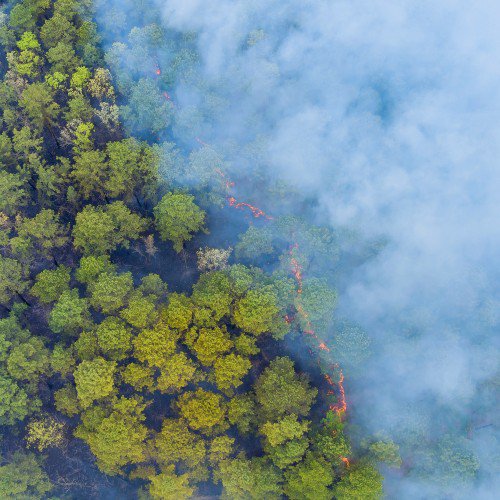
Just as what goes up must come down, what we put into the earth, comes back out. As a result of industrialization, our soils have become contaminated with heavy metals like lead, cadmium, nickel, chromium, arsenic, selenium, and several others [16]. Harmful toxins allowed to degrade into the soil eventually make their way back to us, be it through plants, animals, or other aspects of the food chain.
There is a process called biosorption, in which biological materials are used as toxin absorbents. As mentioned above, the Pleurotus species (of which Oyster mushrooms are a member) holds incredible power to absorb heavy metals and other petroleum wastes in soil, in large part due to the extensive amount of mycelium it produces compared to other species. This enlarged amount of biomass gives it an increased surface area to accumulate heavy metals from within the soil. These mycelial networks are essentially a highway, allowing toxins to accrue and localize along the path, where they are then degraded or transformed by fungal enzymes into other, less toxic compounds [32].
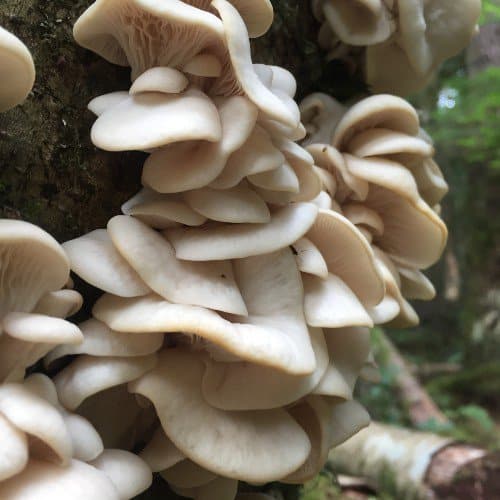
This mycelium “highway” is also quite helpful in terms of shuttling resources. For instance, nutrients can be shuttled from the mycelium to the plant roots it associates with, giving a boost of life to the botanic organisms it interacts with.
Though humans have thus far discovered certain methods of degrading what was previously considered ‘non-biodegradable,’ our methodologies pale in comparison to the natural technology of mycoremediation. Previously developed processes have been too slow, too expensive, or inefficient. However, by utilizing biosorption, heavy metals can be extracted from soil, analyzed as a bioindicator of which toxins are present, and passively converted onto the surface of a biosorbent material—in this case, mycelium and their mushrooms.
Mycoremediation is relevant to the soil pollution solution as demonstrated by researcher Savannah Volkoff, Ph.D. from the Duke Research Center. Her mycoremediation approach capitalized on biostimulation, a process by which current native species are stimulated through targeted analysis. Specifically, she used gene sequencing to develop a test that would scan fungal ecosystems for useful bioremediating species in polluted soils.
Specifically, she identified fungal species that would decontaminate soil containing PAHs (Polycyclic Aromatic Hydrocarbons). This ubiquitous pollutant is released as a byproduct of plastic production and can cause a slew of adverse health conditions in humans [27].
She used available ecological information to determine which fungi from the area’s soil composition would be most useful in absorbing toxins like PAH. Finally, she applied the appropriate substrate to fuel proliferative fungi growth of the already-existent, native fungi within the soil [33].
In essence, what she proposed boils down to simply utilizing fungal resources that are known to degrade toxins and are already present and native to the area, and encouraging their proliferation by feeding them with the appropriate substrate that will speed up their growth and therefore their bioremediation capacity.
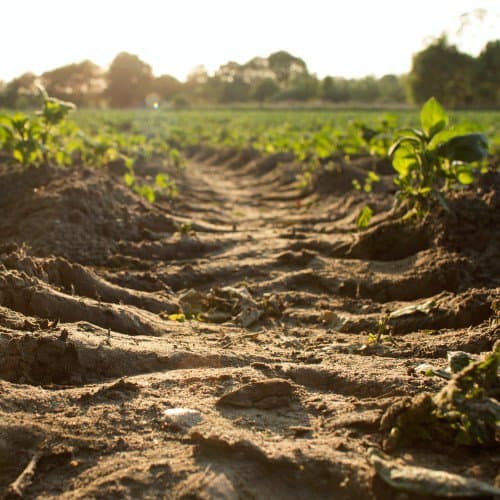
Paul Stamets, in collaboration with Battelle Laboratories, was able to demonstrate the soil-remediating power of mycelium to create an entire thriving ecosystem from a previously diesel-contaminated field. Multiple fields full of oil contamination were tested, each with a different approach to restorative efforts. The field that was inoculated with oyster mushroom spores was later found to be the only field left standing, so to speak. Of all the plots, it had biodegraded the most toxic oil and replaced what was once a contaminated wasteland with a thriving ecosystem. This experiment took the soil’s PAH count (the concentration of this often carcinogenic aromatic hydrocarbon) from 10,000 parts per million (ppm) to less than 200 ppm in eight weeks [23].
Lastly, a recent mycoremediation invention by 22-year-old Kelcie Miller-Anderson could effectively change the oil and gas industry and the issue of its toxic tailing ponds forever. Tailings are segregated holding ponds into which industrial waste from bitumen mines is dumped. Every barrel of bitumen extracted from oil sands results in 1.5 barrels of tailings waste, and this waste requires indefinite containment [48]. Meanwhile, tailings water and its pollutants can leach into the surrounding soil, and can potentially contaminate groundwater and harm wildlife surrounding the pond.
Miler-Anderson developed the MycoMat, a roll-out mat that is inoculated with oyster mushroom mycelium. It can then be rolled out onto tailings ponds or the surrounding soil. The fungi release powerful enzymes that make a meal of harmful hydrocarbons. Initial test results indicate that the fungi can digest and eliminate the hydrocarbons in contaminated soil in only 21 days. Additionally, the mats themselves are completely biodegradable.
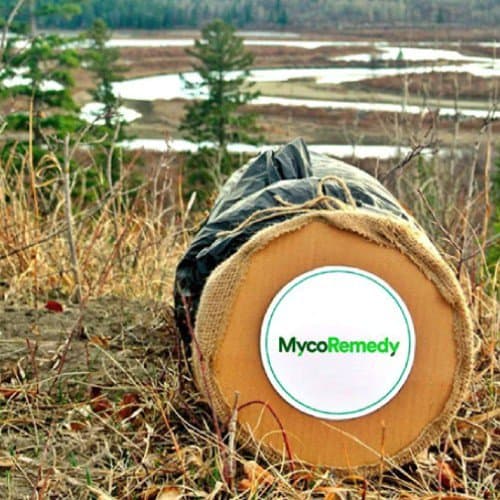
Mycoremediation has hopeful implications for developing countries, where produce is heavily relied on, yet the soil is being destroyed and rendered unfit for edible food production [15]. It also has hopeful implications right here at home, where our society runs on fossil fuels that we pump out more than we bioremediate.
Even if we stopped making plastic products today, the amount of non-biodegradable plastic waste in existence would still be monumental. In 2016, Planet Earth pumped out 242 million tons of plastic waste [26]. Low-waste lifestyles and minimizing single-use plastic can aid in slowing down our production, but what are we to do with the mess we’ve already made? In short, we are bioremediate.
Plastics wreak havoc on our environment throughout their lifespan. The extraction and transportation of fossil fuels used to make plastic alone emit an estimated 12.5 to 13.5 million metric tons of carbon dioxide every year [34].
Plastic is often single-use and, therefore, has a short life span. So what happens when plastic is ready for disposal? In developed countries, it’s either recycled, dumped in a landfill, or, worst case, incinerated [34].
Incineration is the most environmentally damaging step in plastic’s lifespan. In 2015, the U.S. emitted 5.9 million metric tons of carbon dioxide from plastic incineration. And if plastic incineration rates continue to rise, greenhouse gas emissions will climb to 49 million metric tons by 2030 [34].
Studies estimate that one-third of all plastic waste ends up in our soil or freshwater. Most of these plastics break down into particles smaller than 5 millimeters, called microplastics. These particles can disintegrate even smaller into nanoparticles (less than .1 micrometer in size) [35].
Since these plastic particles are so small and plentiful, they can effortlessly end up in our water and food sources. Fish ingest plastics from swimming in microplastic-infested waters, which in turn, enter our bodies when we eat seafood. Microplastics have also been detected in salt, sugar, and beer. It’s estimated that microplastics can be found in all earthly organisms [35].
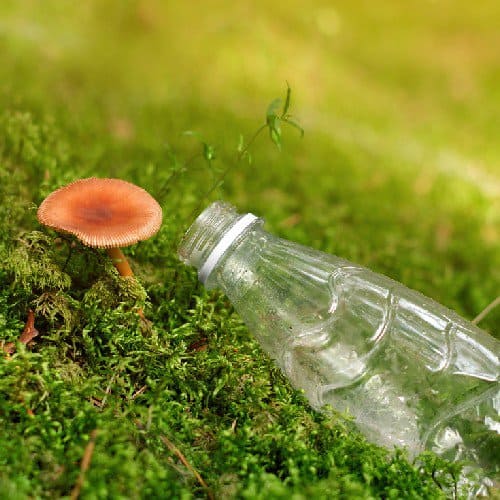
These plastic particles contain a plethora of toxic compounds including BPA, an endocrine disrupter. Furthermore, PAH (Polycyclic Aromatic Hydrocarbons) released as a byproduct of plastic production can cause a slew of adverse medical conditions in humans [27].
But what makes plastic even more damaging is it can attract and bind to other toxic compounds, including lead, PCBs, and pesticides. Researchers suggest that all of these toxic compounds can leak out of degrading plastics into their environment, whether that be soil, water, or living tissue [36].
Mycoremediation provides hope for combating the environmentally damaging implications of plastic. For example, certain fungi play an important role in how effectively forests can absorb carbon dioxide, the gas emitted from plastic incineration. Researchers have found that forests that have a high population of a root fungus called ectomycorrhizal fungus absorb CO2 emissions at a faster rate [37].
Several species of Kingdom Fungi have now been identified with the ability to degrade plastics and PAHs, including Pleurotus ostreatus (Oyster Mushroom) [1, 4], Trametes Versicolor (Turkey Tail) [9], and Lentinula edodes (Shiitake) [5].
In one study, researchers used oyster mushrooms to degrade oxo-biodegradable (D2W) plastic, a material that’s often used to make shopping bags. The mushrooms demonstrated their mycoremediation capabilities within 45 days. They even degraded the synthetic dye found on the bags [4]. Synthetic dyes are another major environmental pollutant, and oyster mushrooms have been found to be one of the most effective fungal species for degrading them [51].
Turkey tail fungi (Trametes Versicolor) have demonstrated versatility and ease of use when it comes to mycoremediation of PAH-polluted soil. Not only can they degrade a wide variety of PAHs, but also their metabolites. In other words, Turkey Tail fungi will devour plastic pollutants completely and leave behind only benign bi-products of their feasting. This fungus will proliferate and work even under non-sterile conditions, which makes its application in bioremediation relatively simple [50].
When activated with vanillin, shiitake mushrooms can effectively degrade an environmentally hazardous compound called 2,4-dichlorophenol (DCP). DCP is a ubiquitous environmental pollutant categorized as a priority pollutant by the United States (US) Environmental Protection Agency, posing adverse health effects on humans and wildlife. On their own, shiitake mushrooms can degrade DCP by 15% within 24-28 days. When activated with vanillin, it eliminates DCP by 92% within the same amount of time [5].
A type of white-rot fungus called Phanerochaete chrysosporium can effectively decompose phenolic compounds and man-made plastics, as seen in the photo below. What remains after the mycelium has devoured the plastic’s hydrocarbons is bio-matter that can safely be disposed of.
Burying the remains of the spoon in soil will, in fact, help this mycelium propagate. As will be discussed in the next section on the mycoremediation of forests, spreading mycelium networks is helpful to the environment.
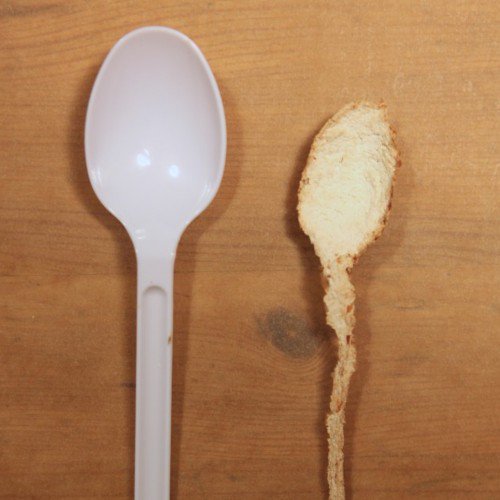
This is part of the reason studying mycoremediation is so pertinent and is coming to the forefront of modern science. In a world where we are operating on a ticking time clock to save the planet we live on before we can destroy it, mycoremediation is perhaps one of our greatest hopes because it is natural and multi-functional.
Mushrooms have a fascinating history of forming symbiotic relationships with plants. In fact, Kingdom Fungi is postulated to be a primary factor enabling plants to move from aquatic life to land. Modern research has confirmed that 90% of vascular land plants are living in some symbiotic relationship with mycorrhizal fungi [31].
When living in a symbiotic relationship, mushroom mycelium is able to entangle itself with plant roots, aiding in water and nutrient distribution to the plant, and protecting the roots both physically and chemically from infection and disease. The largest mushroom species on Earth is only 1 cell wall thick, yet it has somehow escaped fatal pathogen and bacterial infection for millennia.
Fungi are perhaps one of our most potent natural antibiotic weapons, inclusive of protecting plants of the forest from infection [19]. In return, the plants are able to transmit carbohydrates created from photosynthesis, which the mycelium happily munch on for sustenance. It’s for this reason that native mushroom species can be strategically planted to speed up reforestation efforts in lands previously devastated by deforestation in a process called mycoforestry.
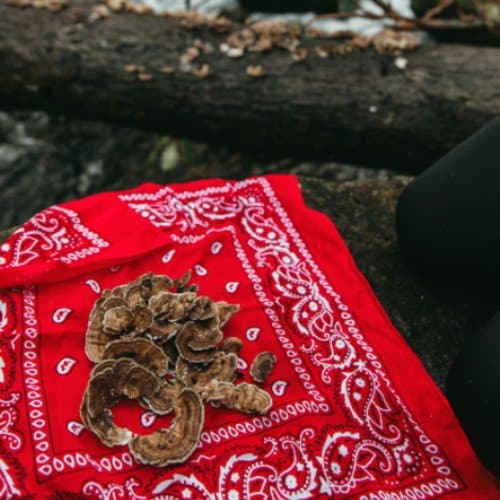
By bringing saprophytic (wood-eating) fungi in close contact with dead wood, we can launch the immune system of the forest and generate nutrient-abundant soil for new plants and trees to grow and thrive in.
Wood chips can be used to encourage the growth of mycelia networks—they increase the surface area available to mycelia for ingestion. By utilizing mycoforestry practices, we can help remedy the forests and lands that have been devastated by deforestation [19].
Furthermore, certain species of fungi have been shown to help attract insects with larvae that provide food for fish and birds. By encouraging the spread of fungi, we help sustain a robust and healthy ecosystem.

Much like the way a placenta feeds a growing fetus, mycelium fuels the mushrooms. It also has a multi-directional relationship with the root systems of plants, the composition of the soil, and nearly every living thing they come into contact with. In short, mycelium is the silent protector of the forest and holds the power to give the pesticide industry a run for its money [23].
If you have ever purchased fresh produce from a grocery store, you may know that in North America, it is routine to wash your produce before eating. This is to avoid ingesting pesticides that were sprayed on the growing plants in an effort to keep pests away. Synthetic pesticides can contain a plethora of toxic chemicals that can cause serious harm to organisms and the environment [38]. So, many researchers are turning to fungi as a solution for a non-toxic biopesticide.
There are about 1,000 known species of entomopathogenic fungi–the type of fungi that kill or incapacitate pests. Combined, they prey on most, if not all, agricultural pests [39].
One of the most popular fungal biopesticides used is Beauveria bassiana, a type of fungus that grows in soil around the world. Beauveria bassiana effectively infects weevils, Colorado potato beetles, mites, and other pests with a disease called white muscardine. After the insect is killed, the fungus continues to produce and release new infective spores into the environment [40]. This fungus is a promising and healthy replacement for chemical crop pesticides.
Metarhizium is a species of fungi that is known to infect a wide range of arthropods, such as beetles, ticks, and ants. When the spores of Metarhizium come into contact with an arthropod, they stick to their exoskeleton and then spread to other anthropods they come into contact with. The spores germinate and feed off the anthropods, depleting them of nutrients. Metarhizium is also known to produce compounds that are toxic to arthropods. These toxins are believed to suppress the host’s immune defenses and aid in killing it. Like Beauveria bassiana, metarhizium can reproduce and release spores into its environment after its host dies [41, 42].
In a TED talk given by Paul Stamets, he described using a non-sporulating variety of metarhizium fungi species to trick carpenter ants into being attracted to it.
The ants bring the fungi to their queen, and within a matter of days, his home, which was previously being destroyed by carpenter ants, was completely void of the infestation. Not only were these entomopathogenic fungi able to help him get rid of his carpenter ant problem, but once the mushrooms popped out of these mummified ant bodies, the house also became a deadly place for termite, fire ant, or carpenter ant infestations [23]. This is one of many examples of the ways mycelium acts as a natural and safer alternative to chemical pesticides.
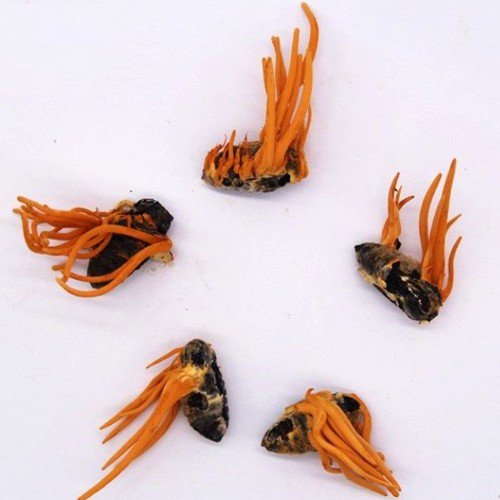
Discoveries in this field are enticing not only for mycoremediation but also for their potential human benefits. Cordyceps is another species of fungi known to be an entomopathogenic (insect-killing) species. In a field survey, cordyceps were able to infect 80% of coconut root grubs, a pest that damages the roots of coconut palms and other crops [43].
Not only can it keep pests away, but when studied in humans, Cordyceps has shown to be a powerful nootropic with cognitive benefits for the human brain [44] This could both help avoid the use of chemical pesticides as well as enhance our own human health and cognition in the process.
To take it a step further, mycorrhizal fungi can improve crop yields, convert pesticides and herbicides into less harmful compounds, and can even remove heavy metals from sites previously contaminated with chemicals [44, 45].
Not only can fungi feed on decaying wood, remove toxins from the soil and water, and clean up our pesticide problem, but they have to potential to help eliminate some of the most toxic of environmental wastes: nuclear radiation.
After mycelium and mushrooms were found on the walls of the Chernobyl reactor in 1991, 5 years after the Chernobyl nuclear disaster, the floodgates were opened for research into cooperating with mycoremediation to reverse the devastation caused by toxic radiation.
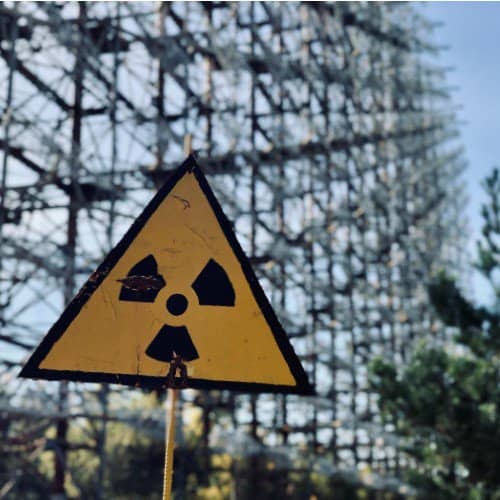
Micro-fungi that are rich in melanin (the pigment found in our skin) have an uncannily high resistance to ionizing radiation exposure. It is these kinds of fungi species that have been extracted from the Chernobyl plant post-devastation. Radiotrophic fungi such as these use radiation as an energy source for growth. In another example of biosorption, these kinds of fungi are able to mineralize radionuclides from their environment and incorporate them into their own biomass [17].
However, it would be a disservice to leave out that the half-life of radionuclide accumulation in fruiting bodies may take 3-8 years based on the most recent estimate [17]. Even in spite of this, we have no current viable methods of reversing radioactive devastation, making mycoremediation, once again, the hero of the day. The potential for fungi to help in the remediation of radioactive zones may be one of the only viable solutions to a complex environmental conundrum.
We live in a society where we literally insulate our houses with fiberglass-containing products, where we bury our dead in coffins that can take up to 125 years to decompose, and our meat production industry produces exorbitant amounts of greenhouse gas emissions. All of these practices cause damage to ourselves and our planet.
However, through mycoremediation techniques, Kingdom Fungi can help us replace these toxic institutions and so much more. Myco-insulation is an invention that capitalizes on the fact that mycelium has the ability to hold up to 30,000 times its mass, while still being incredibly lightweight and insulating [23].
This has created the potential for living houses, which also fosters the idea that not only would we use nature, but we might live in a harmonic symbiosis with it. Being able to grow insulation is what will also enable the production of buildings in remote environments, such as Mars! The process of creating structures out of mycelium is called myco-architecture.
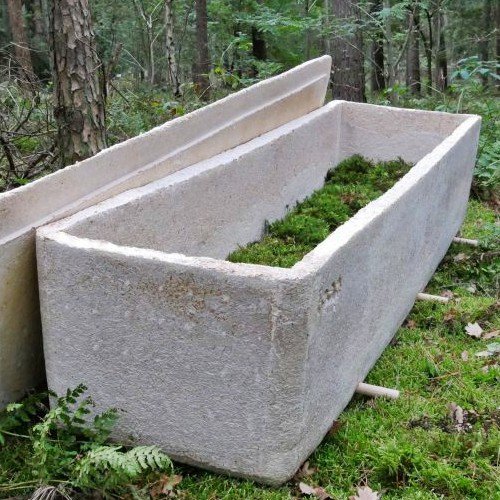
Other objects, such as furniture and even coffins, can be made entirely of mycelium grown on substrates like sawdust. Living coffins are now being created from mycelium, with the hope of replacing graveyards and cemeteries with beautiful forests created from dead humans. Companies, such as Loop, who are building mycelium coffins, highlight the fact that groundwater re-activates the mycelium, enabling the coffins to become one with nature again within 45 days.
With regards to the food industry, a plethora of mushroom species can imitate some of the most savory carnivorous delicacies we have the luxury to consume in our everyday lives (for example: Lion’s Mane mushroom is a fantastic substitute for crab meat when cooked correctly, or try Chicken of the Woods to replace poultry)! Atlast Food Co is now making a bacon substitute from mycelium. Many meat dishes can use less meat with equivalent flavor when mushrooms are used as a substitute [53].
One study found that supplementing the diet of cattle with the spent substrate of golden needle mushroom (Flammulina velutipes) lowered the amount of CO2 emissions produced [52].
By lowering the global volume of cattle farming, we can not only reduce CO2 emissions, but we can support other, more ethical substitutes for animal products. Such is the perspective taken by companies developing mushroom mycelium-based leather.
Mylo is the brand name of fungi-derived vegan leather which is being used commercially by fashion brands such as Stella McCarthy, Adidas, and Lululemon. Not only does this material eliminate the need for animal husbandry and toxic tanning chemicals, but it repurposes waste from the forestry industry (to be used as the substrate for growing the mycelium) and is produced in minimal time and with few resources. Unlike the typical leather-replacement materials made from plastic, Mylo is ultimately biodegradable.
The human species is so genetically interrelated to the Kingdom of Fungi that a group of 20 eukaryotic microbiologists recently gave an umbrella term, Opisthokonta, to denote the Super-Kingdom of Animalia and fungi. This was informed by the mutually shared pathogens amongst the two groups [23].
Humans and fungi are much more similar than one might think. We both inhale oxygen, exhale carbon dioxide, and are afflicted by the same pathogens. This creates space for a world of antibiotic innovation, beginning with Penicillin, one of the original mycological antibiotic discoveries that came way ahead of its time.
Fungi have inhabited forests and lands full of bacteria for a billion years, and they have prevailed in nearly every habitat. There are mushrooms that thrive in the wettest of springs and the snowiest of winters, and some mushrooms only appear after an area has been devastated by a forest fire—even after previously lying dormant for hundreds of years. What an incredible testament to their resilient and regenerative properties!
Because of their power to prevail, they have wickedly intelligent abilities to combat bacteria, and we humans are able to utilize that power to derive new microbial-fighting technologies.
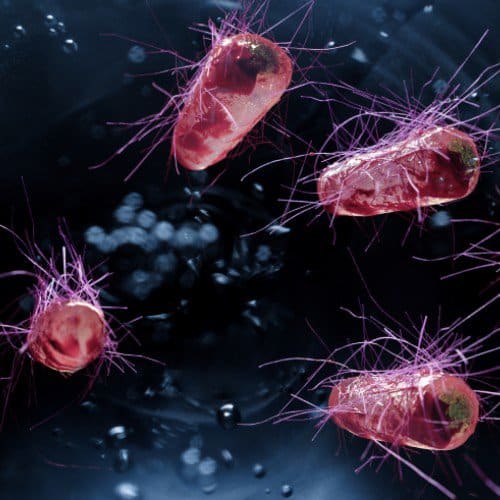
This knowledge has prompted habitat restoration projects to use creative methods such as putting oyster mushroom mycelium in burlap bags and setting them in E. coli-infected water sources to rid them of the bacteria [28].
While the use of fungi for antibacterial purposes isn’t new, there are still many untapped opportunities for using fungi to remediate sources of harmful microbial pollution.
As an interesting side note, there are other revolutionary drugs that have been developed from fungi’s unique functional properties. The immunosuppressant drug Cyclosporine, cholesterol-lowering statins, and the chemotherapy agent Taxol are all derived from fungi.
This quick-reference list outlines a variety of mushrooms & types of pollutants that have the potential to degrade:
Mycoremediation has the potential to solve a great many of the world’s problems. Fungi are miraculous little creatures that have adaptive superpowers. If they can clean up the Earth, imagine what they can do for your body. We are all connected by the fact that we, too, are nature. With the plethora of ways that fungi can help save the planet, imagine how much they can improve your health and add value to your life.
To get health-supporting benefits from fungi, it is important to choose mushroom supplements that are created properly—specifically, this means taking supplements containing 100% mushrooms rather than ones containing mycelium or the substrate it is grown on. Mushrooms, also known as fruiting bodies, are where the highest beta-D-glucan content can be found, which is responsible for a slew of health benefits.
At Real Mushrooms, we create products that are extracted from organic mushrooms, so you can ensure access to the highest quality supplements available. You can peruse the selection of Real Mushrooms supplements here.
For information about how mushrooms can benefit the human body, we suggest reading the article 7 Medicinal Mushrooms’ Benefits for Health.
For more information on how mushrooms can benefit the earth through mycoremediation, we suggest exploring the resource list below.

1 Kulshreshtha S., Mathur N., Bhatnagar P. Mushroom as a product and their role in mycoremediation. AMB Express. 2014;4:29. Published 2014 Apr 1. doi:10.1186/s13568-014-0029-8
2 Purnomo A.S., Mori T., Putra S.R., Kondo R. Biotransformation of heptachlor and heptachlor epoxide by white-rot fungus Pleurotus ostreatus. Int Biodeterior Biodegrad. 2013;4:40–44. doi: 10.1016/j.ibiod.2013.02.013. doi:10.1016/j.ibiod.2013.02.013.
3 Abu-Elsaoud A.M., Nafady N.A., Abdel-Azeem A.M. (2017) Arbuscular mycorrhizal strategy for zinc mycoremediation and diminished translocation to shoots and grains in wheat. PLoS ONE 12(11): e0188220. https://doi.org/10.1371/journal.pone.0188220
4 Da Luz J.M.R., Paes S.A., Nunes M.D., da Silva M.C.S., Kasuya M.C.M. Degradation of Oxo-Biodegradable Plastic by Pleurotus ostreatus. PLoS ONE. 2013;4(8):69386. doi: 10.1371/journal.pone.0069386. doi:10.1371/journal.pone.0069386.
5 Tsujiyama S., Muraoka T., Takada N. Biodegradation of 2,4-dichlorophenol by shiitake mushroom (Lentinula edodes) using vanillin as an activator. Biotechnol Lett. 2013;4:1079–1083. doi: 10.1007/s10529-013-1179-5. doi:10.1007/s10529-013-1179-5.
6 Eskander S.B., Abd El-Aziz S.M., El-Sayaad H., Saleh H.M. (2012) Cementation of bioproducts generated from biodegradation of radioactive cellulosic-based waste simulates by mushroom. ISRN Chemical Engineering, doi:10.5402/2012/329676
7 Rajput Y., Shit S., Shukla A., Shukla K. Biodegradation of malachite green by wild mushroom of Chhatisgrah. J Exp Sci. 2011;4:69–72
8 Olusola S.A., Anslem E.E. Bioremediation of a crude oil polluted soil with Pleurotus Pulmonarius and Glomus Mosseae using Amaranthus Hybridus as a test plant. J Bioremed Biodegrad. 2010;4:111. doi:10.4172/2155-6199.1000113
9 Jang K.Y., Cho S.M., Seok S.J., Kong W.S., Kim G.H., Sung J.M.. Screening of biodegradable function of indigenous ligno-degrading mushroom using dyes. Mycobiology. 2009;4:53–61. doi: 10.4489/MYCO.2009.37.1.053
10 Nagy B., Măicăneanu A., Indolean C., Mânzatu C., Silaghi-Dumitrescu M.C. (2013) Comparative study of Cd(II) biosorption on cultivated Agaricus bisporus and wild Lactarius piperatus based biocomposites. Linear and nonlinear equilibrium modelling and kinetics J Taiwan Inst Chem E. doi:10.1016/j.jtice.2013.08.013.
11 Sutherland C., Venkobachar C. Equilibrium modeling of Cu (II) biosorption onto untreated and treated forest macro-fungus Fomes fasciatus. International Journal of Plant, Animal and Environment Sciences. 2013;4:193–203.
12 Lamrood PY, Ralegankar SD. Biosorption of Cu, Zn, Fe, Cd, Pb and Ni by non-treated biomass of some edible mushrooms. Asian J Exp Biol Sci. 2013;4:190–195.
13 Lamrood P.Y., Ralegankar S.D. Biosorption of Cu, Zn, Fe, Cd, Pb and Ni by non-treated biomass of some edible mushrooms. Asian J Exp Biol Sci. 2013;4:190–195.
14 Oyetayo V.O., Adebayo A.O., Ibileye A. Assessment of the biosorption potential of heavy metals by Pleurotus tuber-regium. Int J Advanced Biol Res. 2012;4:293–297
15 Azmat, R. (2014, March 18). Phytoremediation Characteristics of Weeds and Mushrooms as a Metal Scavenger in Restoring Metal Contaminated Soil. Science Alert. https://scialert.net/fulltext/?doi=biotech.2014.28.31#ref.
16 Kumar A. et al. (2019) Fungal Phytoremediation of Heavy Metal-Contaminated Resources: Current Scenario and Future Prospects. In: Yadav A., Singh S., Mishra S., Gupta A. (eds) Recent Advancement in White Biotechnology Through Fungi. Fungal Biology. Springer, Cham. https://doi.org/10.1007/978-3-030-25506-0_18
17 Fungi and ionizing radiation from radionuclides - Oxford
18 Stamets, P. (2016, February 18). How Mushrooms Can Clean Up Radioactive Contamination - An 8 Step Plan. Permaculture magazine. https://www.permaculture.co.uk/articles/how-mushrooms-can-clean-radioactive-contamination-8-step-plan.
19 Fusi, E. (2020, January 15). Speeding up the recovery of forests with fungi is very real - Alquimia - Centre of Healing Arts. Alquimia. https://alquimiahealingarts.com/speeding-up-the-recovery-of-forests-with-fungi-is-very-real/.
20 Sheldrake, M. (2020, September 23). The Fungal Evangelist Who Would Save the Bees - Issue 90: Something Green. Nautilus. https://nautil.us/issue/90/something-green/the-fungal-evangelist-who-would-save-the-bees.
21 Could Mushrooms Help Save the Honeybee? Great Ecology. (2016, June 21). https://greatecology.com/2016/06/21/could-mushrooms-help-save-the-honeybee/.
22 Young, R., & Raphelson, S. (2019, January 28). One Mycologist On Why Fungi Are 'Critical For The Survival Of Life On This Planet'. One Mycologist On Why Fungi Are 'Critical For The Survival Of Life On This Planet' | Here & Now. https://www.wbur.org/hereandnow/2019/01/28/mushrooms-fungi-disease-bees.
23 Stamets, P. (n.d.). Transcript of "6 ways mushrooms can save the world". TED. https://www.ted.com/talks/paul_stamets_6_ways_mushrooms_can_save_the_world/transcript?language=en#t-13690.
24 Reid, K. (2021, May 17). Global water crisis: Facts, FAQs, and how to help. World Vision. https://www.worldvision.org/clean-water-news-stories/global-water-crisis-facts.
25 Smout, B. (2017, May 4). Oyster mushroom (Pleurotus ostreatus) water filter for removal of sediments and atrazine. Warren Wilson College. http://wwcnscapstone.org/2017/05/04/oyster-mushroom-pleurotus-ostreatus-water-filter-for-removal-of-sediments-and-atrazine/.
26 WHAT A WASTE 2.0. Tackling Increasing Plastic Waste. (n.d.). https://datatopics.worldbank.org/what-a-waste/tackling_increasing_plastic_waste.html#:~:text=In%202016%2C%20the%20world%20generated,million%20tonnes%20from%20North%20America.
27 Centers for Disease Control and Prevention. (2013, December 10). Polycyclic Aromatic Hydrocarbons (PAHs): What Health Effects Are Associated With PAH Exposure? Centers for Disease Control and Prevention. https://www.atsdr.cdc.gov/csem/polycyclic-aromatic-hydrocarbons/health_effects.html.
28 Pini, A.K., Geddes, P. Fungi Are Capable of Mycoremediation of River Water Contaminated by E. coli. Water Air Soil Pollut 231, 83 (2020). https://doi.org/10.1007/s11270-020-4464-7
29 Mycoremediation Services. MycoLogic. (n.d.). https://www.mycologic.nz/mycoremediation-services.
30 Kaur, A. (2008, January). Oil Spill Removal by Mycoremediation. ResearchGate. https://www.researchgate.net/publication/330975530_Oil_Spill_Removal_by_Mycoremediation.
31 Spinosa, R. (2008, Spring). Fungi and sustainability, Fungi. 1:1.
32 Post-Fire watershed Defense. CoRenewal. (n.d.). https://www.amazonmycorenewal.org/post-fire-watershed-defense.html.
33 Volkoff, S., & Gunsch, C. (2018, August). Mycoremediation: Evaluating fungal metagenomics and biofilm association in PAH-contaminated estuarine sediments. In ABSTRACTS OF PAPERS OF THE AMERICAN CHEMICAL SOCIETY (Vol. 256). 1155 16TH ST, NW, WASHINGTON, DC 20036 USA: AMER CHEMICAL SOC.
34 Bauman, B. (2021, April 2). Why plastics can be garbage for the climate. Yale Climate Connections. https://yaleclimateconnections.org/2019/08/how-plastics-contribute-to-climate-change/.
35 Machado, A. A. de S., Kloas, W., Zarfl, C., Hempel, S., & Rillig, M. C. (2018, January 31). Microplastics as an emerging threat to terrestrial ecosystems. Wiley Online Library. https://onlinelibrary.wiley.com/doi/10.1111/gcb.14020.
36 Gallo, F., Fossi, C., Weber, R., Santillo, D., Sousa, J., Ingram, I., Nadal, A., & Romano, D. (2018). Marine litter plastics and microplastics and their toxic chemicals components: the need for urgent preventive measures. Environmental sciences Europe. https://www.ncbi.nlm.nih.gov/pmc/articles/PMC5918521/.
37 Averill, C., Dietze, M. C., & Bhatnagar, J. M. (2018, July 27). Continental‐scale nitrogen pollution is shifting forest mycorrhizal associations and soil carbon stocks. Wiley Online Library. https://onlinelibrary.wiley.com/doi/abs/10.1111/gcb.14368.
38 Environmental Protection Agency. (n.d.). Exposure Assessment Tools Chemical Classes Pesticides. EPA. https://www.epa.gov/expobox/exposure-assessment-tools-chemical-classes-pesticides.
39 Mora, M. A. E., Castilho, A. M. C., & Fraga, M. E. (2018, January 22). Classification and infection mechanism of entomopathogenic fungi. Arquivos do Instituto Biológico. https://www.scielo.br/j/aib/a/7RCCHwZ4YhQWpdVVZfJ6LXG/?lang=en.
40 Groden, E. (1999). Integrated Pest Management. Using Beauveria Bassiana for Insect Management - CT Integrated Pest Management Program. http://ipm.uconn.edu/documents/raw2/Using%20Beauveria%20Bassiana%20for%20Insect%20Management/Using%20Beauveria%20Bassiana%20for%20Insect%20Management.php.
41 Ugine, T. (n.d.). Metarhizium. https://biocontrol.entomology.cornell.edu/pathogens/Metarhizium.php.
42 Aw, K. M. S., & Hue, S. M. (2017, June 7). Mode of Infection of Metarhizium spp. Fungus and Their Potential as Biological Control Agents. Journal of fungi (Basel, Switzerland). https://www.ncbi.nlm.nih.gov/pmc/articles/PMC5715920/.
43 Santhosh, K. T., & Aparna, N. S. (2014, February 10). Cordyceps SPECIES AS A BIO-CONTROL AGENT AGAINST COCONUT ROOT GRUB, Leucopholis coneophora BURM. Kasargod; Journal of Environmental Research And Development.
44 Yuan, G., An, L., Sun, Y., Xu, G., & Du, P. (2015, March 15). Improvement of Learning and Memory Induced by Cordyceps Polypeptide Treatment and the Underlying Mechanism. National Center for Biotechnology Information. https://www.ncbi.nlm.nih.gov/pmc/.
45 Zhang, S., Lehmann, A., Zheng, W., You, Z., & Rillig, M. C. (2018, November 29). Arbuscular mycorrhizal fungi increase grain yields: a meta‐analysis. New Phytologist Foundation. https://nph.onlinelibrary.wiley.com/doi/10.1111/nph.15570.
46 Rhodes, C. J. (2015, January 12). Mycoremediation (bioremediation with fungi) – growing mushrooms to clean the earth. Berkshire; Taylor & Francis Group.
47 Mehta, A., Dubey, R., & Kumar, S. (2017, June 10). Mycofiltration: A Step Towards Sustainable Environment. Uttarakhand; International Journal of Current Microbiology and Applied Sciences.
48 Pembina Institute. (June 19, 2015). Tailings Ponds [Online]. Available: http://www.pembina.org/oil-sands/tailings-ponds
49 Earth Repair. (n.d.). Mycoremediation. Earthrepair.Ca. Retrieved August 7, 2021, from https://earthrepair.ca/resources/bioremediation-types/mycoremediation/
50 Borràs Camps, E. (2012). Evaluation of Trametes versicolor ability to bioremediate Polycyclic Aromatic Hydrocarbons (PAHs) in different matrices (thesis).
51 Kunjadia, P.D., Sanghvi, G.V., Kunjadia, A.P. et al. Role of ligninolytic enzymes of white rot fungi (Pleurotus spp.) grown with azo dyes. SpringerPlus 5, 1487 (2016). https://doi.org/10.1186/s40064-016-3156-7
52 Rangubhet, K. Teepalak & Mangwe, Mancoba & Mlambo, Victor & Fan, Y.K. & Chiang, Hsin-I. (2017). Enteric methane emissions and protozoa populations in Holstein steers fed spent mushroom ( Flammulina velutipes ) substrate silage-based diets. Animal Feed Science and Technology. 234. 10.1016/j.anifeedsci.2017.06.005.
53 Myrdal Miller A, Mills K, Wong T, Drescher G, Lee SM, Sirimuangmoon C, Schaefer S, Langstaff S, Minor B, Guinard JX. Flavor-enhancing properties of mushrooms in meat-based dishes in which sodium has been reduced and meat has been partially substituted with mushrooms. J Food Sci. 2014 Sep;79(9):S1795-804. doi: 10.1111/1750-3841.12549. Epub 2014 Aug 14. PMID: 25124478.
 .
.Disclaimer: The information or products mentioned in this article are provided as information resources only, and are not to be used or relied on to diagnose, treat, cure, or prevent any disease. This information does not create any patient-doctor relationship, and should not be used as a substitute for professional diagnosis and treatment. The information is intended for health care professionals only. The statements made in this article have not been evaluated by the Food and Drug Administration. Any products mentioned are not intended to diagnose, treat, cure, or prevent any disease. The information in this article is intended for educational purposes. The information is not intended to replace medical advice offered by licensed medical physicians. Please consult your doctor or health practitioner for any medical advice.